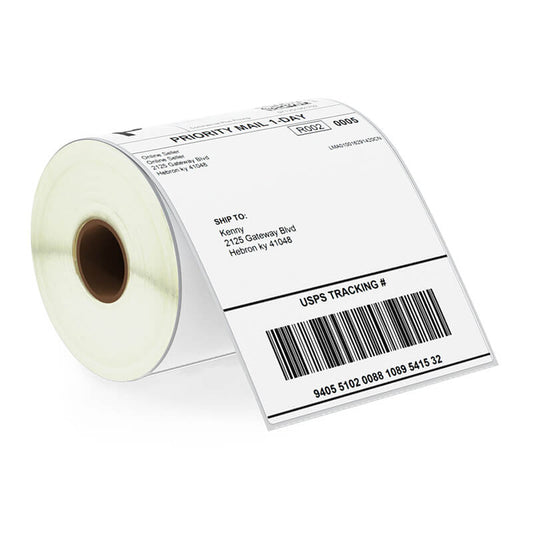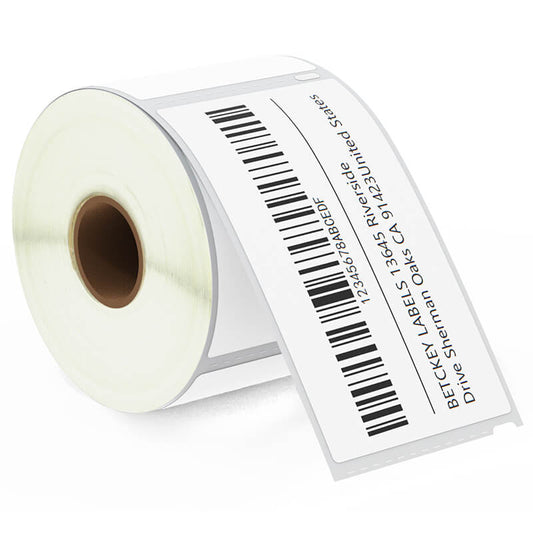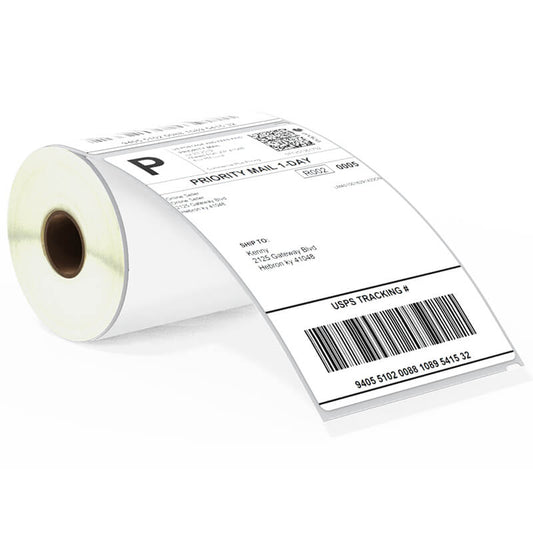

Removable Film Labels

Thermal labels have become an indispensable part of modern business operations across numerous industries, including retail, logistics, healthcare, food service, and manufacturing. Their popularity stems from their ease of use, quick printing capabilities, and overall cost-effectiveness, enabling businesses to efficiently manage inventory, streamline shipping processes, accurately label medical samples, and enhance customer experiences through clear and reliable labeling.
However, when businesses first explore thermal labels, they often encounter confusion between two seemingly similar yet fundamentally distinct types: direct thermal labels and thermal transfer labels. While both use heat to create text, barcodes, and images, their materials, processes, and suitability for specific applications differ significantly. Choosing the wrong type can result in unnecessary costs, poor durability, or compromised label readability.
Understanding these differences clearly helps buyers make informed decisions that directly impact efficiency, product quality, operational costs, and ultimately, business success. In this article, we'll explore in detail what sets direct thermal labels apart from thermal transfer labels, their respective advantages and disadvantages, and how to choose the best option for your particular needs.
Definition and Working Principle
Direct thermal labels are a type of label that doesn't require ink, toner, or ribbons to produce printed images or text. Instead, these labels rely on a special heat-sensitive coating that reacts to the heat generated by a thermal print head. When exposed to precise heat patterns, this coating chemically darkens, instantly forming clear, readable print directly on the surface of the label itself.
The printing process is straightforward: the thermal print head selectively applies heat to the coated label material as it moves beneath the head, activating the chemicals in specific areas. This produces sharp, clear images, barcodes, text, or graphics in a simple, efficient manner without additional consumables.

Main Characteristics of Direct Thermal Labels:
Heat-Sensitive Material:
Direct thermal labels are made from paper or synthetic material specially treated with a thermochromic coating. This unique coating is the key to enabling printing without ink or ribbon.
No Ink or Ribbon Needed:
Eliminating ink, toner, or ribbons simplifies the printing process, reduces operational complexity, and lowers overall printing costs.
Short- to Medium-Term Durability:
Because direct thermal labels react to heat and environmental factors, they're best suited for shorter-term applications. Extended exposure to sunlight, heat, moisture, or friction can cause the printed information to fade or darken prematurely.
Cost-Effectiveness and Simplicity:
The absence of ribbons or ink cartridges significantly reduces both initial investment and ongoing maintenance costs, making these labels particularly appealing for businesses handling large-volume, temporary labeling tasks.
Sensitive to Environmental Factors:
Direct thermal labels require careful handling and storage, as their printed information may degrade due to heat, sunlight (UV exposure), moisture, friction, or certain chemicals.
Direct thermal labels are most commonly used for applications such as shipping labels, receipts, ticketing, visitor passes, and food packaging labels—where rapid printing, cost efficiency, and relatively short lifespan are essential considerations.
Direct thermal labels offer several unique advantages but also have limitations to consider. Understanding both sides helps businesses determine if they're suitable for their specific needs.
1. Cost-Effective Printing
Direct thermal labels do not require ribbons, ink cartridges, or toners, significantly reducing initial investment and ongoing operational costs. This makes them ideal for businesses that need high-volume labeling at the lowest possible expense.
2. Simple, Efficient Operation
The absence of ribbons or inks simplifies the printing process considerably. Businesses don't have to manage additional supplies, change ribbons, or deal with complicated printer maintenance, leading to smoother, hassle-free daily operations.
3. Fast Printing Speed
Direct thermal labels enable quick and efficient printing because the process only involves the printer's thermal head and label material. Rapid production is ideal for fast-paced environments like retail checkouts, logistics, warehousing, and food service.
4. Reliable, Clear Print Quality
When stored and handled correctly, direct thermal labels produce crisp, high-resolution barcodes, text, and graphics, enhancing readability and accuracy. They are especially effective for short-term applications, such as shipping labels and receipts.
5. Easy-to-Use Printers
Direct thermal printers are compact, user-friendly, and require minimal technical expertise. This ease-of-use allows businesses to train staff quickly and manage printing efficiently.
1. Limited Lifespan
Because the print is produced through a chemical reaction on heat-sensitive material, direct thermal labels tend to fade or darken over time. They're generally suitable for short-term applications, ranging from weeks to months, depending on storage and usage conditions.
2. Sensitivity to Environmental Factors
Direct thermal labels can be sensitive to heat, friction, moisture, sunlight (UV rays), and certain chemicals. Any prolonged exposure to these elements could prematurely degrade the label’s readability, potentially causing issues with barcode scanning or product identification.
3. Unsuitable for Extreme Conditions
Direct thermal labels are not recommended for applications that involve long-term outdoor exposure, harsh chemical environments, or extreme temperatures. In these challenging conditions, printed information may rapidly deteriorate, necessitating frequent replacement.
4. No Color Options
Direct thermal printing typically produces monochrome (black) prints only. Businesses needing colored labels or specialized branding on labels must consider thermal transfer or other printing technologies.
5. Storage and Handling Requirements
To maintain label quality, direct thermal labels require careful storage in a controlled environment away from sunlight, moisture, chemicals, and high temperatures. Improper storage can cause labels to degrade prematurely.
Definition and Working Principle
Thermal transfer labels are printed by transferring ink from a ribbon onto the label surface using heat applied by a thermal print head. Unlike direct thermal labels—which utilize heat-sensitive materials—thermal transfer labels require a ribbon coated with wax, resin, or a wax-resin combination. When heat is applied to the ribbon by the thermal printer’s print head, the ink melts and transfers precisely onto the label, creating clear, durable text, graphics, and barcodes.
The printing process involves three key components:
Label Material: Typically made from paper or synthetic substrates like polyester or polypropylene.
Thermal Ribbon: Contains ink coating (wax, resin, or wax-resin) that transfers onto the label.
Thermal Print Head: Selectively heats the ribbon, transferring ink onto the label’s surface in sharp, high-quality images.
This method provides exceptional print clarity and durability, suitable for demanding environments or long-term labeling requirements.
Main Characteristics of Thermal Transfer Labels:
1. Ribbon Required
Thermal transfer printing uses ribbons, adding consumable cost and operational complexity compared to direct thermal labels. However, these ribbons significantly enhance durability and print quality.
2. Excellent Print Durability
Because the printed image comes from ink transferred onto the label, thermal transfer labels are highly resistant to smudging, scratching, fading, and environmental conditions. This makes them ideal for long-term or heavy-duty applications.
3. Versatile Label Materials
Thermal transfer labels are available in diverse materials, including paper, polyester, polypropylene, and vinyl. This range allows them to be tailored precisely to the application environment—whether outdoor exposure, chemical resistance, extreme temperatures, or high-abrasion situations.
4. Longevity and Reliability
Labels printed with thermal transfer technology typically have an extended lifespan, maintaining clear readability over months or even years without degradation. This is especially beneficial in inventory management, asset tracking, and identification labels.
5. Supports Color and Specialty Applications
Thermal transfer ribbons come in various colors and types, enabling labels with colored text or graphics. Specialty inks—such as metallic, fluorescent, or security inks—can also be utilized, enhancing labeling capabilities and brand visibility.
6. Higher Initial Cost and Maintenance
Compared to direct thermal labels, thermal transfer labels involve additional costs for ribbons and increased printer maintenance. Regular ribbon replacement and periodic cleaning are necessary to maintain optimal printing performance.
| Aspect | Direct Thermal Labels | Thermal Transfer Labels |
|---|---|---|
| Ribbon Required? | No (prints directly onto heat-sensitive labels) | Yes (uses ribbon coated with wax, resin, or wax-resin inks) |
| Durability | Short-term (weeks to months) | Long-term (months to years) |
| Environmental Resistance | Low (susceptible to heat, UV, moisture, chemicals) | High (excellent resistance to heat, UV, moisture, abrasion, chemicals) |
| Cost-effectiveness | High (minimal consumables, lower upfront costs) | Moderate (additional cost of ribbon and maintenance) |
| Printing Speed | Very Fast (simple, rapid process) | Moderately Fast (ribbon transfer slightly reduces speed) |
| Maintenance Requirements | Low (minimal cleaning required) | Moderate (requires ribbon replacement and periodic cleaning) |
| Print Quality | Good (clear but limited durability) | Excellent (crisp, long-lasting print quality) |
| Color Printing Capability | Limited (primarily black print) | Versatile (multiple colors and specialty inks available) |
| Material Options | Primarily heat-sensitive paper or coated synthetics | Wide variety (paper, polyester, polypropylene, vinyl, synthetic) |
| Ideal Usage Environment | Indoors, controlled environments | Harsh, outdoor, industrial, or extreme environments |
| Storage Conditions | Requires careful handling, controlled conditions | Flexible, resistant to challenging conditions |
| Common Applications | Shipping labels, receipts, visitor passes, tickets, short-term labels | Product labels, asset tags, inventory tracking, chemical labeling, medical labels |
| Lifecycle Cost | Lower initial and operational costs | Higher initial cost but potentially lower long-term costs due to durability |
Selecting between direct thermal and thermal transfer labels requires careful consideration of various operational and practical factors. Here are four essential aspects to help guide your decision-making:
Short-term vs. Long-term Use
Direct Thermal Labels:
Ideal for short-duration applications, generally ranging from a few weeks to several months. They are optimal for scenarios where labels don't need long-term readability or resistance to fading, such as:
Shipping and logistics labels
Retail receipts
Event tickets or passes
Food labels indicating expiration or packaging dates
Thermal Transfer Labels:
Best suited for applications where labels must remain clearly readable for an extended period—often months, years, or even permanently. Examples include:
Asset identification tags
Inventory and warehouse tracking labels
Compliance or certification labels
Product labels requiring durable identification over a product’s lifecycle
Exposure to Harsh Conditions vs. Controlled Environments
Direct Thermal Labels:
Sensitive to environmental factors such as heat, sunlight, humidity, chemicals, and friction. They're best used in indoor environments with controlled temperature, humidity, and minimal exposure to physical stress.
Thermal Transfer Labels:
Highly resistant to challenging environments, providing durability against:
Extreme temperatures (both hot and cold)
Outdoor exposure (UV rays, sunlight, weather)
Chemicals, solvents, oils, and cleaning agents
Abrasion and frequent handling
Therefore, thermal transfer labels are particularly valuable in:
Industrial manufacturing plants
Automotive and electronics industries
Medical and pharmaceutical environments
Outdoor labeling (garden products, construction materials, equipment)
Initial Investment vs. Long-Term Value
Direct Thermal Labels:
Offer a more economical initial investment with lower upfront printer costs and no additional expenses for ribbons or inks. They're cost-effective for businesses needing high-volume, temporary labels without durability concerns. Maintenance costs are also minimal due to the simplified printing process.
Thermal Transfer Labels:
Typically involve higher upfront costs for printers and ongoing costs for ribbons. However, the exceptional durability can significantly reduce long-term expenses, particularly when labels don't need frequent replacement. Over time, this can offset the higher initial investment, resulting in substantial cost savings for certain applications.
When performing a budget analysis, consider:
Frequency of label replacement
Costs associated with unreadable or damaged labels
Maintenance and consumable expenses over the label’s lifecycle
Tailored Requirements Across Industries
Different industries have distinct labeling demands that affect the choice of labels:
Logistics and Retail:
Often require short-term labeling solutions. Direct thermal labels are typically sufficient for shipping labels, receipts, tickets, and temporary inventory management.
Healthcare and Pharmaceuticals:
Labels must be durable, highly readable, and resistant to solvents or chemicals. Thermal transfer labels provide the durability needed for medical instruments, specimen labeling, and medication labels.
Manufacturing and Industrial:
Asset tagging, equipment identification, and chemical-resistant labeling demand the durability and resistance of thermal transfer labels.
Food Service and Hospitality:
Direct thermal labels work well for labeling food packaging, order tickets, expiration date labeling, and similar short-duration tasks.
Evaluating specific industry requirements is crucial to ensuring that labels meet regulatory standards, operational needs, and customer expectations.
Direct thermal labels contain a heat-sensitive coating that darkens upon contact with the thermal printer’s heated print head. This reaction creates the printed text or images without needing ink, toner, or ribbons.
Direct thermal labels usually last from a few weeks to several months, depending on storage conditions and environmental exposure. Heat, sunlight, moisture, and friction can shorten their lifespan.
Standard direct thermal labels are not inherently waterproof, as exposure to moisture can cause damage or discoloration. However, specialized synthetic direct thermal labels with water-resistant coatings are available for short-term applications involving limited moisture exposure.
No, direct thermal printing typically produces only monochrome (black) images. The technology does not support full-color or multicolor printing.
Direct thermal labels should be stored in a cool, dry, and dark environment, away from direct sunlight, heat sources, moisture, and chemicals to prevent premature discoloration or degradation.
Direct thermal labels are generally not recommended for outdoor applications due to their sensitivity to sunlight, heat, moisture, and other environmental factors. For outdoor use, thermal transfer labels are a more suitable choice.

Betckey — Premium Label Solutions for Every Business
About Betckey
Betckey is a trusted provider of high-quality thermal labels designed for eCommerce, logistics, and office operations. We focus on delivering dependable label solutions that are fully compatible with Rollo, Zebra, Dymo, and Brother printers.
Whether you're running a small shop or scaling up a warehouse, Betckey ensures your labeling process is smooth, professional, and cost-effective.
Read more →

24/7 support team

Multiple Payment Methods

Worry-free shopping

Delivery in 3-7 business days
Be the first to know about label discounts,
product launches, and time-saving tips — subscribe now!
Are you 18 years old or older?
Sorry, the content of this store can't be seen by a younger audience. Come back when you're older.
They are exactly what I need, very easy to use!!!
Everithing was really good, fast delivery, product quality 100% guarantee
Very versatile label for mailing addresses and a marketing to promote a product or get someone’s attention.
Brother DK-2205 Compatible Continuous Labels 2.4" x 100'
Great little labels to use in pricing jewelry. Saves a lot time when you use with a thermal printer. I use on the hang tags and other display cards. Will definitely reorder in the future.
The label is perfect it's very recommended to everyone
iLabel 4x6 Thermal Shipping Label Printer Bluetooth Wireless
Dymo 30256 Removable Film Waterproof Shipping Labels 2-5/16” x 4”









